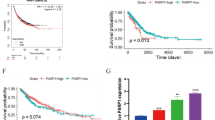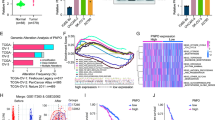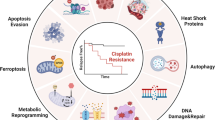Abstract
Cisplatin (DDP) is the first-line chemotherapy drug widely used for the treatment of lung cancer patients, whereas the majority of cancer patients will eventually show resistance to DDP. The mechanisms responsible for DDP resistance are not fully understood. Tongue cancer resistance-associated protein 1 (TCRP1) gene was recently cloned and reported to specially mediate DDP resistance in human oral squamous cell carcinoma (OSCC) cells. However, the mechanisms of TCRP1-mediated DDP resistance are far from clear, and whether TCRP1 participates in DDP resistance in lung cancer cells remains unknown. Here, we show that TCRP1 contributes to DDP resistance in lung cancer cells. Knockdown of TCRP1 sensitizes the cells to DDP and increases the DDP-induced DNA damage. We have identified that Pol β is associated with DDP resistance, and Pol β knockdown delays the repair of DDP-induced DNA damage in A549/DDP cells. We find TCRP1 interacts with Pol β in lung cancer cells. Moreover, TCRP1 knockdown decreases the level of Pol β and increases the level of its ubiquitination. These results suggest that TCRP1 contributes to DDP resistance through the prevention of Pol β degradation in lung cancer cells. These findings provide new insights into chemoresistance and may contribute to prevention and reversal of DDP resistance in treatment of lung cancer in the future.





Similar content being viewed by others
References
Ferlay JSI, Ervik M, Dikshit R, Eser S, Mathers C, Rebelo M, Parkin DM, Forman D, Bray F (2013) GLOBOCAN 2012 v1.0, Cancer Incidence and Mortality Worldwide: IARC CancerBase No. 11 [Internet]. Lyon, France: International Agency for Research on Cancer. http://globocan.iarc.fr/Default.aspx
Bray F, Ren JS, Masuyer E, Ferlay J (2013) Global estimates of cancer prevalence for 27 sites in the adult population in 2008. Int J Cancer 132:1133–1145
Novello S, Besse B, Felip E, Barlesi F, Mazieres J et al (2014) A phase II randomized study evaluating the addition of iniparib to gemcitabine plus cisplatin as first-line therapy for metastatic non-small cell lung cancer. Ann Oncol
Arriagada R, Bergman B, Dunant A, Le Chevalier T, Pignon JP et al (2004) Cisplatin-based adjuvant chemotherapy in patients with completely resected non-small-cell lung cancer. N Engl J Med 350:351–360
Siddik ZH (2003) Cisplatin: mode of cytotoxic action and molecular basis of resistance. Oncogene 22:7265–7279
Enoiu M, Jiricny J, Scharer OD (2012) Repair of cisplatin-induced DNA interstrand crosslinks by a replication-independent pathway involving transcription-coupled repair and translesion synthesis. Nucleic Acids Res 40:8953–8964
Martin LP, Hamilton TC, Schilder RJ (2008) Platinum resistance: the role of DNA repair pathways. Clin Cancer Res 14:1291–1295
Dasari S, Bernard Tchounwou P (2014) Cisplatin in cancer therapy: Molecular mechanisms of action. Eur J Pharmacol 740C:364–378
Galluzzi L, Vitale I, Michels J, Brenner C, Szabadkai G et al (2014) Systems biology of cisplatin resistance: past, present and future. Cell Death Dis 5:e1257
Stordal B, Davey M (2007) Understanding cisplatin resistance using cellular models. IUBMB Life 59:696–699
Shen DW, Pouliot LM, Hall MD, Gottesman MM (2012) Cisplatin resistance: a cellular self-defense mechanism resulting from multiple epigenetic and genetic changes. Pharmacol Rev 64:706–721
Gu Y, Fan S, Xiong Y, Peng B, Zheng G et al (2011) Cloning and functional characterization of TCRP1, a novel gene mediating resistance to cisplatin in an oral squamous cell carcinoma cell line. FEBS Lett 585:881–887
Peng B, Gu Y, Xiong Y, Zheng G, He Z (2012) Microarray-assisted pathway analysis identifies MT1X & NFkappaB as mediators of TCRP1-associated resistance to cisplatin in oral squamous cell carcinoma. PLoS ONE 7:e51413
Gu Y, Fan S, Liu B, Zheng G, Yu Y et al (2011) TCRP1 promotes radioresistance of oral squamous cell carcinoma cells via Akt signal pathway. Mol Cell Biochem 357:107–113
Peng B, Yi S, Gu Y, Zheng G, He Z (2012) Purification and biochemical characterization of a novel protein-tongue cancer chemotherapy resistance-associated protein1 (TCRP1). Protein Expr Purif 82:360–367
Olive PL, Banath JP (2009) Kinetics of H2AX phosphorylation after exposure to cisplatin. Cytom B Clin Cytom 76:79–90
Muid KA, Karakaya HC, Koc A (2014) Absence of superoxide dismutase activity causes nuclear DNA fragmentation during the aging process. Biochem Biophys Res Commun 444:260–263
Olive PL, Banath JP (2006) The comet assay: a method to measure DNA damage in individual cells. Nat Protoc 1:23–29
Kang TH, Lindsey-Boltz LA, Reardon JT, Sancar A (2010) Circadian control of XPA and excision repair of cisplatin-DNA damage by cryptochrome and HERC2 ubiquitin ligase. Proc Natl Acad Sci U S A 107:4890–4895
Basu A, Krishnamurthy S (2010) Cellular responses to Cisplatin-induced DNA damage. J Nucleic Acids 2010
Li K, Li W (2013) Association between polymorphisms of XRCC1 and ADPRT genes and ovarian cancer survival with platinum-based chemotherapy in Chinese population. Mol Cell Biochem 372:27–33
Freudenthal BD, Beard WA, Shock DD, Wilson SH (2013) Observing a DNA polymerase choose right from wrong. Cell 154:157–168
Pei DS, Yang XJ, Liu W, Guikema JE, Schrader CE et al (2011) A novel regulatory circuit in base excision repair involving AP endonuclease 1, Creb1 and DNA polymerase beta. Nucleic Acids Res 39:3156–3165
Sobol RW (2012) Genome instability caused by a germline mutation in the human DNA repair gene POLB. PLoS Genet 8:e1003086
Bergoglio V, Canitrot Y, Hogarth L, Minto L, Howell SB et al (2001) Enhanced expression and activity of DNA polymerase beta in human ovarian tumor cells: impact on sensitivity towards antitumor agents. Oncogene 20:6181–6187
Iwatsuki M, Mimori K, Yokobori T, Tanaka F, Tahara K et al (2009) A platinum agent resistance gene, POLB, is a prognostic indicator in colorectal cancer. J Surg Oncol 100:261–266
Parsons JL, Tait PS, Finch D, Dianova II, Allinson SL et al (2008) CHIP-mediated degradation and DNA damage-dependent stabilization regulate base excision repair proteins. Mol Cell 29:477–487
Parsons JL, Tait PS, Finch D, Dianova II, Edelmann MJ et al (2009) Ubiquitin ligase ARF-BP1/Mule modulates base excision repair. EMBO J 28:3207–3215
Parsons JL, Dianova II, Khoronenkova SV, Edelmann MJ, Kessler BM et al (2011) USP47 is a deubiquitylating enzyme that regulates base excision repair by controlling steady-state levels of DNA polymerase beta. Mol Cell 41:609–615
Acknowledgments
This work was supported by research grants from the Natural Science Foundation of China (30873088), Natural Science Foundation of Guangdong Province (S2012010008995), and Doctoral fund of Education Ministry of China (20124423110003).
Author information
Authors and Affiliations
Corresponding author
Electronic supplementary material
Below is the link to the electronic supplementary material.
Rights and permissions
About this article
Cite this article
Liu, X., Wang, C., Gu, Y. et al. TCRP1 contributes to cisplatin resistance by preventing Pol β degradation in lung cancer cells. Mol Cell Biochem 398, 175–183 (2015). https://doi.org/10.1007/s11010-014-2217-x
Received:
Accepted:
Published:
Issue Date:
DOI: https://doi.org/10.1007/s11010-014-2217-x




